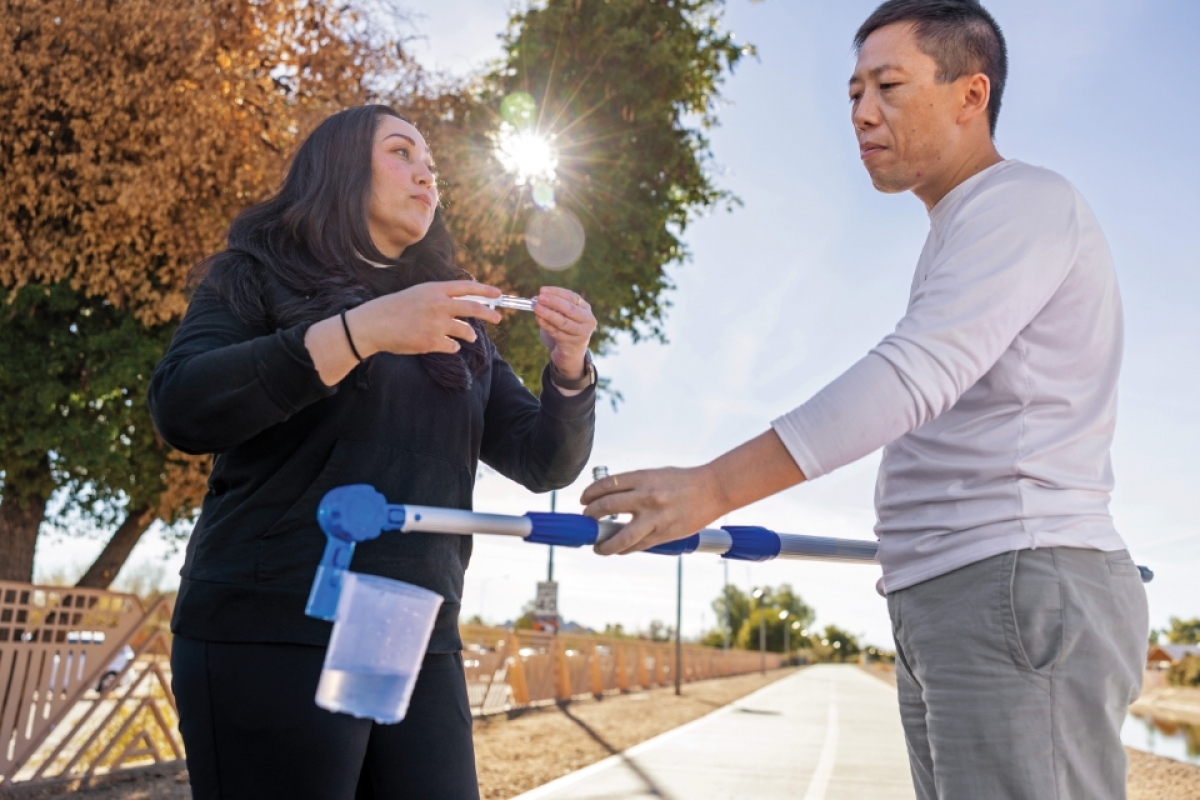Don’t flee the Southwest just yet
Fifth-generation Arizona native sheds light on the Southwest’s water supply

Photo by Chris Goulet/ASU
Editor’s note: First published in The New York Times and then reprinted in the spring 2024 issue of ASU Thrive. Reprinted from The New York Times. First appeared Dec. 31, 2023. From The New York Times. ® 2023 The New York Times Company. All rights reserved. Used under license.
Read the original story in The New York Times at nytimes.com.
Story by Tom Zoellner, a journalist, the author of “Rim to River: Looking Into the Heart of Arizona” and a fifth-generation Arizonan.
This summer, when the temperature hit 110 degrees Fahrenheit or above in Phoenix for 31 straight days, many were fretting about the Southwest’s prospects in the age of climate change. A writer for The Atlantic asked, “When Will the Southwest Become Unlivable?” Bloomberg wondered, “How Long Can We Keep Living in Hotboxes Like Phoenix?”
The foregone conclusion seemed to be that the region was heading for a crash — destined to become an overpopulated, unlivable dead zone, plagued by ranch foreclosures, unemployment, water wars and heat deaths.
As a writer who has studied the Southwest’s history and spoken to some of its top environmental experts this year, I see its future differently — not as a hellscape but as an opportunity for centuries of climate ingenuity and adaptation to be put to good use. For generations, the people who were determined to come here have found ways to cope and even thrive.
The Hohokam people dug extensive networks of canals along the Salt River, while the science-minded Hopi up north grew corn in the arid lowlands. A later generation of Americans built a chain of megadams on the Colorado and other rivers to create a dependable supply of water for households and crops. My great-great-grandmother used to dip bedsheets into a canal and hang them on the sides of the porch of her Phoenix boardinghouse to create a primitive cooling system for sleeping outside in the hottest months.
While our era of shrinking water resources and rising temperatures will undoubtedly test Southwestern states, the question is not when will this region become unlivable. It is: Are we willing to make certain adjustments to live on a new hotter and drier frontier?
The biggest vulnerability may lie in what has traditionally been the biggest strength for the Southwest, at least in economic terms. The low-service and low-tax philosophy of state and local governments, combined with an abundance of former cowboy ranges, made places like Arizona and Nevada a haven for those who couldn’t afford homes in California and Hawaii. Fortune 500 homebuilders stamped out tens of thousands of identical houses with tile roofs faster than Liberty ships in wartime, and the booming exurbs with loose zoning gave the Phoenix metro area a geographical footprint more than twice the size of Kuwait.
But even before July’s heat dome settled over Phoenix, Arizona was being forced to reconsider its pedal-to-metal economic model that has kept the state growing for the past seven decades, after state officials said they would limit building permits for new housing in some areas because of groundwater shortages.
It’s not just groundwater that’s stressed: Consistent lack of snowpack in the Rocky Mountains has thinned out the Colorado River’s flow, upon which 40 million people in seven states depend. After calling on states to make major cuts in their water use, the Interior Department recently agreed to pay jurisdictions in Nevada, California and Arizona a total of $1.2 billion to use less river water in the next three years. A majority of the reduction will come from farmers raising cattle food like alfalfa and hay, the biggest water gobblers of the Southwest.
And as the water crisis grows more dire, the federal and state governments are likely to have to pay off more farmers to have enough water left over to sustain the Southwest’s cities. “There’s no way you can have 400 farmers in the Imperial Valley taking all the water away from Phoenix and the L.A. basin,” according to Brad Udall, a climate research scientist at Colorado State University. As water resource managers like to say, the Southwest’s cities could disappear tomorrow and there would still be a water shortage, thanks to the thirsty farms and hungry cows. One way or another, desert agriculture must shrink and adapt to what remains.
But there’s reason for hope. Take Arizona, a state that’s often seen as the epicenter of the crisis because of its steep population growth and the fact that many of the same Arizona counties attracting new residents at a record pace are also the most water starved, experiencing severe droughts far out of proportion to the rest of the country. In spite of this, many environmental experts in Arizona are relatively sanguine about its future because of all the progress the state has made over the last 50 years to conserve its water supply.
Because of a reduction in farmland acreage and better household conservation, Arizona now uses 3% less water than it did in 1957, despite having a population that’s mushroomed more than 555% since then. Paradoxically enough, the steady march of master-planned communities to the horizon — an Arizona cliché — provides big hydrological savings because of the conversion of water-guzzling farmland into more parsimonious suburban uses, Sarah Porter, the director of the Kyl Center for Water Policy at Arizona State University, told me.
We now use treated wastewater on golf courses and parks. Phoenix is already building a facility to turn wastewater into high-quality drinking water by 2030. And Southwestern cities have an exceptionally simple solution for curbing residential water use: Charge more for it in the summers. After Phoenix started using this powerful incentive, the number of homes with front or back lawns went down from nearly 80% in the 1970s to about 10% today, according to Kathryn Sorensen, a former Water Services director for the city. “That’s a wholesale cultural change,” she said.
Arizona now uses 3% less water than it did in 1957, despite having a population that’s mushroomed more than 555% since then."
Tom Zoellnerjournalist for The New York Times
In some crucial ways, Arizona will actually be better able to adapt to climate change than many coastal areas of the country. For instance, the cost of building sea walls for U.S. coastal regions will be at least $400 billion, according to the Center for Climate Integrity, while squeezing water out of a desert landscape is relatively cheap in comparison. The only necessary ingredient is political willpower. Public agencies will capture and bank more stormwater in the ground for aquifer recharge, for example, and they can require residents to cover their backyard swimming pools to cut down on evaporation.
The historic adaptability of the Southwest can be applied in multiple other ways. Cities can reduce the heat-island effect by planting more street trees and even small forests that capture carbon. They can mandate reflective coatings on roofs and asphalt, encourage low-flow showers and toilets and discourage residential lawns, as Las Vegas has done. Tougher zoning codes on the county level can stem the runaway growth of what firefighters call suicide subdivisions built on the edge of drying forests vulnerable to wildfire.
States and cities must also invest in more emergency cooling shelters to protect the homeless and the residents of mobile home parks on the worst days. “There’s many ways we can adjust to a changing climate,” Peter Schlosser, the director of the Julie Ann Wrigley Global Futures Laboratory at Arizona State University, told me. “It doesn’t mean we have to leave the area.”
I think the Southwest will retain its essential characteristic as a tough frontier. Those who want to enjoy it will adapt accordingly, just as they did in previous centuries.
More Environment and sustainability

Study: Conservation actions highly effective at halting, reversing biodiversity loss
A new study, led and contributed to by Arizona State University faculty, provides the strongest evidence to date that not only is nature conservation successful, but that scaling up conservation…

Barrett Honors College to host nature walks for science, relaxation
Barrett, The Honors College at Arizona State University is gearing up to participate in the City Nature Challenge (CNC) for the fourth consecutive year. This annual event, taking place April 26–29,…

Arizona adapting to heat crisis with initiatives featured in ASU report
Arizona State University's Knowledge Exchange for Resilience, also known as KER, released its Recommendations Report on Extreme Heat Preparedness earlier this April during a summit in the nation's…





